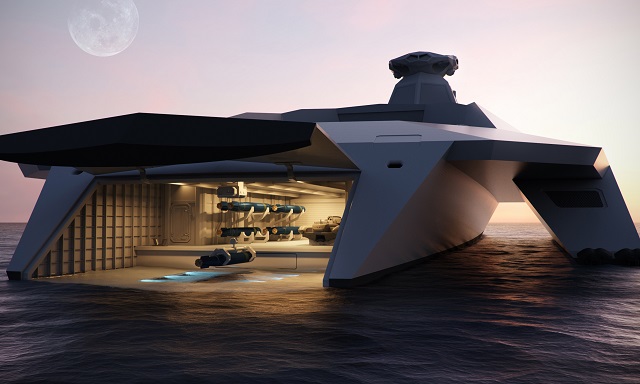 Speed of light weapons; graphene coated, ultra-strong acrylic hull which
can be made see through; tethered quad-copter radar; locally 3-D printed
drones; supercavitating torpedoes and a floodable rear docks all feature.
Speed of light weapons; graphene coated, ultra-strong acrylic hull which
can be made see through; tethered quad-copter radar; locally 3-D printed
drones; supercavitating torpedoes and a floodable rear docks all feature. |
|||
Starting
with the battle management nerve centre of the ship – the fighting
heart of a ship known as the Operations Room - the concepts were developed
by a number of young science and engineering graduates from both the private
and public sector who were asked to visualise what an Operations Room
would look like, and how the actual ship itself might appear. The images of the ‘Ops Room’ as the Navy calls it, are developed around a 3-D holographic command table and communications hubs to give the crew greatly improved situational awareness when engaged in future operations. The command table could be rotated and zoomed, to allow commanders to focus on specific aspects of the battlefield be it in the air, on the surface both at sea and on land, or underwater. Additional, smaller holographic pods would allow the crew to manage those specific environments in greater detail. An operation could be commanded from within visual range, to thousands of miles away from the ship; all managed by five or six people. Any information could be transmitted in real time, secure voice, video or data to wherever it is needed, be it the UK joint headquarters, NATO or other allies. |
|||
 The T2050 concept demonstrates British ingenuity and expertise in complex design and engineering for both battle management systems and ship design proposals. |
|||
The
type of ship was also subject to discussion in terms of construction materials,
power source, shape, sensors and weapons. The ship’s structure could
be made of ultra-strong acrylic composites which can be turned translucent
to give commanders in the Ops Room a view of close-in operations. The
power would either be a fusion reactor or highly efficient turbines driving
silent electric motors to waterjets; the hull would be coated with graphene
to cut down drag and could be ballasted down to present a lower profile
which would make the ship more stealthy and even harder to detect; the
ship would not have a conventional mast but a tethered quad-copter which
could be flown above the ship. This tether would be made of carbon nanotubes
and cryogenically cooled in order to transmit significant power to the
quad-copter for multi-spectral sensors and act as a high-power (i.e. laser)
weapon to knock down enemy missiles or aircraft. There would be an electro-magnetic
railgun at the bow, capable of firing projectiles the same distance as
today’s long-range cruise missiles; and at the stern there would
be a ‘moon pool’ or floodable dock area to deploy Royal Marines
and other troops on amphibious raiding missions, or unmanned underwater
vehicles (UUVs) to detect mines. Above the floodable dock would be a large,
extendable flight deck and hangar for multiple remotely piloted air systems
(RPAS/UAVs), many equipped with weapons, which could target the enemy
without putting the crew in harm’s way. And along the ship’s
sides would be missile tubes for defensive hypersonic (i.e. Mach 5 plus)
missiles, directed energy weapons to stop small enemy craft loaded with
explosives; and in the armas (the outrigger hulls) would be torpedo tubes
to fire super-cavitating torpedoes capable of 300+ knots. Probably of most importance, the manning of this sort of ship could be brought down significantly. Where today’s modern warships have around 200 crew, a future crew could be brought down to as little as 50-100, with the Ops Room needing only five people rather than today’s 25. Commander Steve Prest, the Royal Navy’sFleet Robotics Officer said: “In 2013 the Royal Navy challenged the defence industry to innovate, and to generate new opportunities to give it an operational edge. We therefore welcome a project that allows some of Britain’s best and brightest young engineers to come up with ideas on what a warship might look like or be equipped with in 2050. We want to attract the best new talent to sea to operate, maintain and develop systems with this level of ambition.” Muir Macdonald, a Senior Executive involved with Startpointsaid: “While some of these technologies push today’s boundaries in science and engineering, there is no reason why elements could not be incorporated into future designs. The Royal Navy needs visionary, innovative thinking and these concepts point the way to cutting edge technology which can be acquired at less cost and operated with less manpower than anything at sea today in the world's leading navies.” Startpoint brings together the best of British expertise in Naval Combat Systems, to showcase innovative concepts, and to help it to attract young talent to a career in the specialist engineering discipline that is combat and mission systems. |
|||
All images copyright Startpoint |
|||
Group of British Naval Companies Unveiled their Warship of the Future: Dreadnought T2050
- Posted On




























